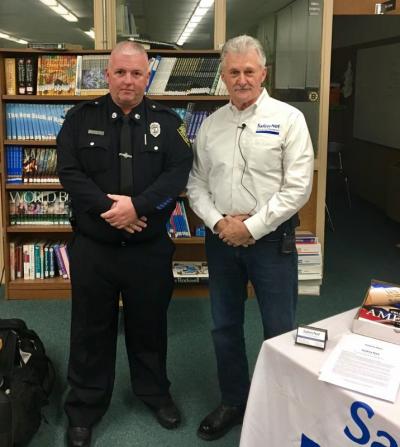Dartmouth police share search and rescue technology, advice
The Dartmouth police and Boston-based company SafetyNet recently shared breakthrough new technology and techniques used in today’s search and rescue operations for some of the most vulnerable people in the community: kids and adults with autism, Alzheimer’s, dementia, brain injuries, and mental illness.
Dartmouth Police Officer Scott Affonce explained these children and adults are members of the so-called “at-risk population,” who tend to wander off.
Speaking at a presentation sponsored by the Special Education Parent Advisory Council on December 14, officers noted that half of children with autism bolt, 60 percent of people with dementia wander, and three out of five people with Alzheimer's wander.
And the longer someone is missing, the greater the odds of serious injury or even death, especially during frigid temperatures. Plus, police warn searching for members of the at-risk population tend to can be extremely challenging, since the missing person could be non-verbal or fearful and hiding from the very police officers looking for them.
But marked improvements in technology are transforming these once daunting rescue operations. In fact, there’s a new wearable device designed for at-risk kids and adults, which can pinpoint the wearer’s precise location, potentially meaning the difference between life and death.
“You can’t hide from this,” according to Ralph Poland, a retired police officer who works with SafetyNet, which sells the wearable tracking device.
The device looks like a wristwatch but it’s actually a transmitter which uses radio frequency to detect the wearer's specific location and transmit it back to a receiver.
Global positioning system (GPS) is a terrific resource, but it only generates a general idea of where something is ‘pinging’ – like, “the lost phone is in the vicinity of the mall.” However, radio frequency is much more powerful and can pinpoint the precise spot as in “the phone is in the northeast entrance of the mall.”
If an at-risk loved one wearing the device goes missing, family members can call the local police station and give them the wearer’s tracking info, which is entered into a database.
Receivers then detect what area the transmitter is in, and officers driving around with antennas on their cruisers in that area can pick up a signal, up to a quarter of a mile away, at which point the officers switch to handheld receivers, which detect the exact location in seconds.
The recently launched product already has received 692 calls across the U.S. since 2010 – and every person has been successfully located. The average search time for a SafetyNet wearer is just half an hour.
And while this device is literally saving lives, Poland also stressed the devices will save police departments – and taxpayers – valuable money and resources. An all-out search for a person can cost up to hundreds of thousands of dollars a day, between the cost of officers, K9s, helicopters, and outside assistance.
Not to mention all of the officers involved in the search aren’t available to help with other emergency calls that come in. The technology is being adopted by police departments all over the country, but right now Poland said “No matter where you are in Massachusetts or Rhode Island, we have full search and rescue.”
And that’s not all being done to find at-risk kids and adults. When Dartmouth police launch a search and rescue mission, they join forces with the Southeastern Massachusetts Law Enforcement Council (SEMLEC), which is composed of over 28 area police departments.
The power of partnering with SEMLEC is that the greater the search and rescue resources, the greater the odds a missing person will be found - both safe and quickly. And SEMLEC has a massive amount of resources, both manpower and equipment, to make this happen.
Manpower-wise, SEMLEC’s search and rescue operations employs three teams, all with different missions: the management team leads the planning and maps out search areas; the ground search team covers urban, suburban, and wilderness searches; and the investigation team gathers information from the family.
SEMLEC also boasts an arsenal of search and rescue equipment and resources, including K9 officers - three alone in Dartmouth - 15 ATVs, with two housed in Dartmouth, night vision goggles, and thermal imagers to detect body heat sensors. All crucial components in a search and rescue.
Dartmouth police also shared some major takeaways for the public in case an at-risk family member goes missing.
Time is of the essence.
Call the police the second you discover your loved one has disappeared.
Affonce shared a common misconception is that families need to wait 24 hours to make a missing person report. But police will kick off the search immediately for a missing member of the at-risk population.
And time is truly of the essence. Affonce explained a lot of families search for loved ones on their own for hours before calling 911 because they “don’t want to bother the police.”
“Even if they’ve been missing five minutes – call us," Affonce said. "You’re not bothering us. We got into this work to help people.”
And the faster the police are on the scene, the greater the likelihood of locating someone. Affonce noted the average person can walk two miles an hour. So waiting even two hours to call the police means the missing person could be four miles away and on the move.
Leave someone at home.
If family members leave the home to join the search, make sure someone – whether a neighbor or friend – stays at the house in case the wandering child or adult returns.
Stay calm.
A missing loved one is a terrifying situation, but remaining calm is the best way to help the family of a lost loved one. That way members can speak with detectives about possible areas the person may have disappeared to or actually search on your own.















